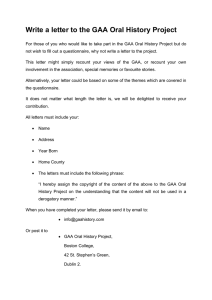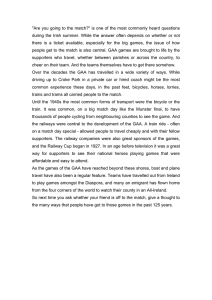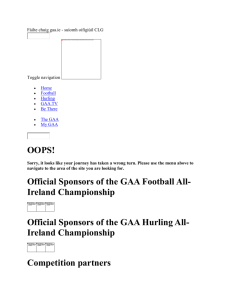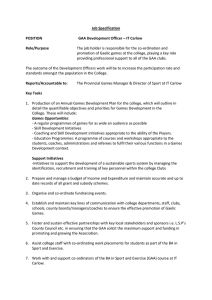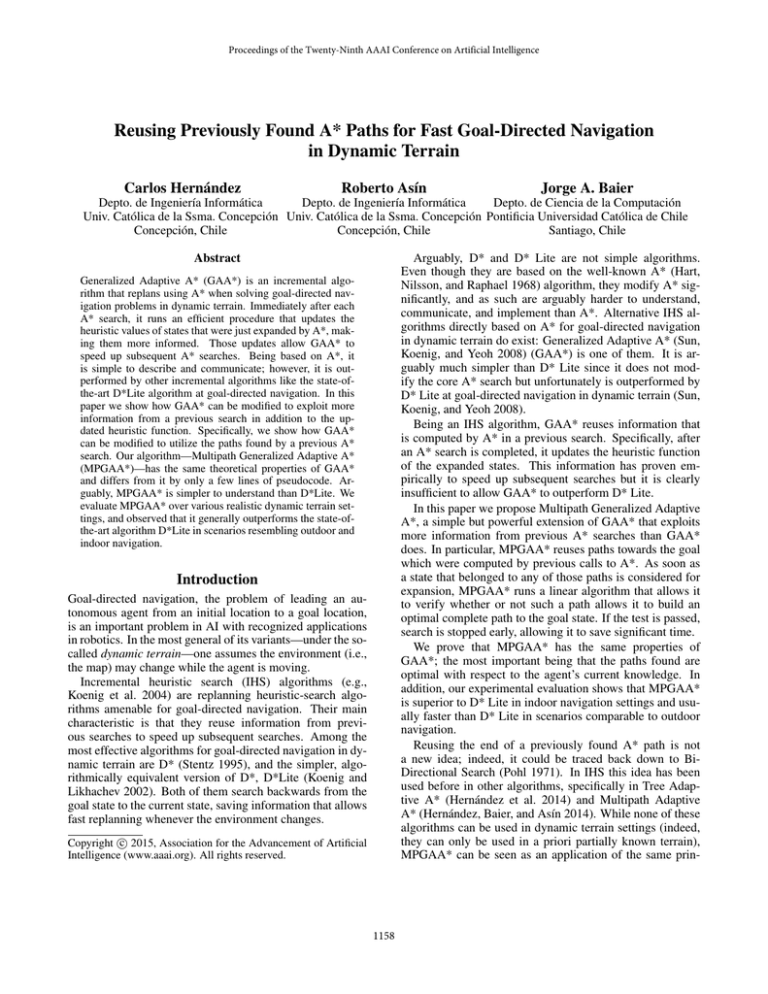
Proceedings of the Twenty-Ninth AAAI Conference on Artificial Intelligence
Reusing Previously Found A* Paths for Fast Goal-Directed Navigation
in Dynamic Terrain
Carlos Hernández
Roberto Ası́n
Jorge A. Baier
Depto. de Ciencia de la Computación
Depto. de Ingenierı́a Informática
Depto. de Ingenierı́a Informática
Univ. Católica de la Ssma. Concepción Univ. Católica de la Ssma. Concepción Pontificia Universidad Católica de Chile
Santiago, Chile
Concepción, Chile
Concepción, Chile
Abstract
Arguably, D* and D* Lite are not simple algorithms.
Even though they are based on the well-known A* (Hart,
Nilsson, and Raphael 1968) algorithm, they modify A* significantly, and as such are arguably harder to understand,
communicate, and implement than A*. Alternative IHS algorithms directly based on A* for goal-directed navigation
in dynamic terrain do exist: Generalized Adaptive A* (Sun,
Koenig, and Yeoh 2008) (GAA*) is one of them. It is arguably much simpler than D* Lite since it does not modify the core A* search but unfortunately is outperformed by
D* Lite at goal-directed navigation in dynamic terrain (Sun,
Koenig, and Yeoh 2008).
Being an IHS algorithm, GAA* reuses information that
is computed by A* in a previous search. Specifically, after
an A* search is completed, it updates the heuristic function
of the expanded states. This information has proven empirically to speed up subsequent searches but it is clearly
insufficient to allow GAA* to outperform D* Lite.
In this paper we propose Multipath Generalized Adaptive
A*, a simple but powerful extension of GAA* that exploits
more information from previous A* searches than GAA*
does. In particular, MPGAA* reuses paths towards the goal
which were computed by previous calls to A*. As soon as
a state that belonged to any of those paths is considered for
expansion, MPGAA* runs a linear algorithm that allows it
to verify whether or not such a path allows it to build an
optimal complete path to the goal state. If the test is passed,
search is stopped early, allowing it to save significant time.
We prove that MPGAA* has the same properties of
GAA*; the most important being that the paths found are
optimal with respect to the agent’s current knowledge. In
addition, our experimental evaluation shows that MPGAA*
is superior to D* Lite in indoor navigation settings and usually faster than D* Lite in scenarios comparable to outdoor
navigation.
Reusing the end of a previously found A* path is not
a new idea; indeed, it could be traced back down to BiDirectional Search (Pohl 1971). In IHS this idea has been
used before in other algorithms, specifically in Tree Adaptive A* (Hernández et al. 2014) and Multipath Adaptive
A* (Hernández, Baier, and Ası́n 2014). While none of these
algorithms can be used in dynamic terrain settings (indeed,
they can only be used in a priori partially known terrain),
MPGAA* can be seen as an application of the same prin-
Generalized Adaptive A* (GAA*) is an incremental algorithm that replans using A* when solving goal-directed navigation problems in dynamic terrain. Immediately after each
A* search, it runs an efficient procedure that updates the
heuristic values of states that were just expanded by A*, making them more informed. Those updates allow GAA* to
speed up subsequent A* searches. Being based on A*, it
is simple to describe and communicate; however, it is outperformed by other incremental algorithms like the state-ofthe-art D*Lite algorithm at goal-directed navigation. In this
paper we show how GAA* can be modified to exploit more
information from a previous search in addition to the updated heuristic function. Specifically, we show how GAA*
can be modified to utilize the paths found by a previous A*
search. Our algorithm—Multipath Generalized Adaptive A*
(MPGAA*)—has the same theoretical properties of GAA*
and differs from it by only a few lines of pseudocode. Arguably, MPGAA* is simpler to understand than D*Lite. We
evaluate MPGAA* over various realistic dynamic terrain settings, and observed that it generally outperforms the state-ofthe-art algorithm D*Lite in scenarios resembling outdoor and
indoor navigation.
Introduction
Goal-directed navigation, the problem of leading an autonomous agent from an initial location to a goal location,
is an important problem in AI with recognized applications
in robotics. In the most general of its variants—under the socalled dynamic terrain—one assumes the environment (i.e.,
the map) may change while the agent is moving.
Incremental heuristic search (IHS) algorithms (e.g.,
Koenig et al. 2004) are replanning heuristic-search algorithms amenable for goal-directed navigation. Their main
characteristic is that they reuse information from previous searches to speed up subsequent searches. Among the
most effective algorithms for goal-directed navigation in dynamic terrain are D* (Stentz 1995), and the simpler, algorithmically equivalent version of D*, D*Lite (Koenig and
Likhachev 2002). Both of them search backwards from the
goal state to the current state, saving information that allows
fast replanning whenever the environment changes.
c 2015, Association for the Advancement of Artificial
Copyright Intelligence (www.aaai.org). All rights reserved.
1158
ciple underlying Multipath Adaptive A*. As such, the specific technical contribution of this paper is to (1) show how
to exactly integrate these ideas into GAA*, and (2) an experimental evaluation showing that MPGAA* is a superior
algorithm for goal-directed navigation in dynamic terrain.
The rest of the paper is organized as follows. We start
off formally describing the problem of goal-directed navigation in dynamic terrain and describing GAA*. We then describe our algorithm and perform a theoretical analysis. We
continue presenting our experimental evaluation in random,
indoor- and outdoor-like terrain. We finish by discussing
some related work and conclusions.
search space whereas for other arcs some standard assumption is made about its cost (in 8-connected grids, for example, it is assumed√
that such cost is 1 for vertical and horizontal moves and 2 for diagonal moves). This assumption
is usually referred to as the freespace assumption (Zelinsky
1992).
Heuristic-search approaches to solving path-planning
problems in dynamic terrain use a heuristic function h.
Given a graph G = (V, E) and a goal state sgoal , h : V → R
is such that h(s) is a non-negative estimate of the cost of a
path from s to sgoal . Function h is admissible iff for every
state s, h(s) does not overestimate the cost of any path from
s to sgoal , with respect to the current cost function c. Furthermore, we say h is consistent if for every (s, t) ∈ E it
holds that h(s) ≤ c(s, t) + h(t), and h(sgoal ) = 0. It is easy
to prove that consistency implies admissibility. Finally, we
say that h(s) is perfect iff it is equal to the cost of an optimal
path from s to sgoal .
Path-Planning in Dynamic Terrain
A path-planning problem in dynamic terrain is a tuple P =
(G, γ, sstart , sgoal ), where G = (V, E) is an undirected
graph where V is a set of states, E is a set of arcs, sstart ,
the start state, and sgoal , the goal state, are both in V , and
γ = c0 c1 . . . is an infinite sequence of cost functions, each
of which maps each element in E to a non-negative value
in R ∪ {∞}. Sequence γ is used to model the fact that the
terrain changes as the agent moves, and the cost value ∞ is
used to represent the fact that states may, in practice, become
disconnected from its neighbors in G.
An agent acting in a dynamic terrain follows a path over
G, which is a sequence of states s0 s1 . . . sn such that for
all i ∈ {1, . . . , n}, it holds that (si−1 , si ) ∈ E. The cost
Pn−1
of a path s0 . . . sn over G is i=0 ci (si , si+1 ).1 A path
σ = s0 . . . sn is a solution to path-planning problem P if
s0 = sstart , sn = sgoal , and the cost of σ is finite. Observe
that even if there exists a path between sstart and sgoal over
G it cannot be guaranteed that there exists a solution to P ,
because this depends on γ.
Generalized Adaptive A*
A straightforward way of using the well-known A* algorithm for goal-directed navigation in dynamic terrain is as
follows: (1) run a forward A* from the current state to the
goal, (2) follow the path returned until the goal has been
reached or until the cost function of the graph has changed,
in which case go back to (1). This algorithm has been referred to as Repeated A* (Koenig and Likhachev 2002).
Generalized Adaptive A* (GAA*) (Sun, Koenig, and
Yeoh 2008) can be understood as a very simple extension
of Repeated A*. It differs from it in two aspects. First, after
each A* search it updates the h-values of all states in A*’s
closed list, making them more informed. The way GAA*
does this has a desirable property: if the heuristic was consistent, it remains consistent and, consequently, optimality
is guaranteed in subsequent searches. The second aspect by
which GAA* differs from Repeated A* is that it may update
the h-values of some states of the search space when it observes that the cost of an arc has decreased. This update is
needed to reestablish the consistency of the heuristic, which
can be broken when arc costs decrease.
The pseudocode of GAA* is shown as Algorithm 1. By
removing Lines 68–69, which run the heuristic updates that
aim at making h more informed, and Lines 39–40, which
call the procedure for reestablishing consistency, GAA*
would become Repeated A*.
Now we describe further details of the pseudocode. We
assume H(s, sgoal ) (used in the initialization; Lines 59–
62) is an admissible estimate of the cost of a path between
the s and sgoal with respect to the initial cost function c.
Once a path is found by A* function BuildPath sets
the next(s) pointer for each state s along the path found
by A*. Variable search(s) returns the number of the last
search in which s was generated; it is equal to 0 if s has
never been generated. Before every A* search, the variable counter is incremented; this variable is used by procedure InitializeState to set g(s) to infinity when
s has not been generated during the current search. We
point out that Lines 38 and 74, which set the next pointer
Solving a Path-Planning Problem
We assume that an agent solving a problem P has partial
knowledge about the terrain. This is represented by the fact
that, during execution, the agent knows the search graph G,
but does not have access to the sequence of cost functions γ.
Rather, it believes that the actual cost function is c. As the
agent moves through the terrain it may observe the true cost
of a subset of the arcs in E and update its cost function c accordingly. The exact subset of arcs that can be observed depends on an additional parameter, called the visibility range,
which intuitively defines a set of arcs whose cost can be observed by the agent depending on its position. Most realistic
dynamic terrain settings involve a restricted visibility range,
which includes only arcs that connect states whose distance
from the current state is bounded. Realistic settings also assume that successive cost functions in γ differ in the cost
assigned to a few arcs only. Finally, if one assumes the terrain is known a priori, then c = c0 ; otherwise if the terrain
is partially known c is equal to c0 for some of the arcs of the
1
Note that here we assume that the cost structure of the graph
can may only change with an agent movement. This is a general
assumption if we allow no-ops, which can be modeled via zero-cost
self-loops in G.
1159
to null in different situations, are not strictly necessary in
a GAA* implementation, and thus removing them will not
change its behavior. Finally, we remark that procedure
ReestablishConsistency is a simple modification
of Dijkstra’s algorithm, which upon termination guarantees
that h(s) = mins0 ∈Succ(s) c(s, s0 ) + h(s0 ), for each s that
was ever added to the priority queue Q.
Algorithm 1: Generalized Adaptive A* Pseudo-Code
1 procedure InitializeState(s)
2
if search(s) 6= counter then
3
g(s) ← ∞
4
search(s) ← counter
5 function GoalCondition (s)
6
return s = sgoal
7 procedure A*(sinit )
8
InitializeState(sinit )
9
parent(sinit ) ← null
10
g(sinit ) ← 0
11
Open ← ∅
12
insert sinit into Open with f-value g(sinit ) + h(sinit )
13
Closed ← ∅
14
while Open =
6 ∅ do
15
remove a state s from Open with the smallest f-value g(s) + h(s)
16
if GoalCondition(s) then
17
return s
Properties of Generalized Adaptive A*
Sun, Koenig, and Yeoh (2008) proved the following property
of Generalized Adaptive A*.
Theorem 1 (Consistency Preservation) If h is consistent
with respect to cost function c, then it remains consistent after the heuristic update of Lines 68–69, and it remains consistent after a call the call to observe function in Line 76.
This results allows to prove that Generalized Adaptive A* is
optimal, in the following sense.
Theorem 2 (Optimality) The movement performed in
Line 75 lies on an optimal path to sgoal over graph G with
respect to (current) cost function c.
In other words, optimality here intuitively refers to the fact
that the agent always does the best it can, given its current
knowledge about the terrain.
Unfortunately, given that the terrain is dynamic, it is not
possible to prove that the algorithm terminates finding a solution even if every cost function in γ is such that a finitecost path between the current state and the goal exists. Indeed, since the agent always follows an optimal path to the
goal, it is not hard to see that one can design a sequence of
cost functions that would make GAA* enter an infinite loop.
It is simple to prove however that the algorithm produces a
correct solution:
Theorem 3 (Soundness) If at each iteration the visibility
range allows observing the true cost of all arcs out of sstart
and the algorithm terminates with sstart = sgoal , then the
sequence of movements produced by GAA* defines a solution to the path-finding problem.
Finally, the following property establishes that GAA*’s
update rule is yields a perfect heuristic for states along the
path to the goal.
Proposition 1 Let σ denote the path found by A* after the
call in Line 65. After the update in Lines 68–69, h(s) is
perfect for every s in σ.
18
19
20
21
22
23
24
25
insert s into Closed
for each s0 ∈ succ(s) do
InitializeState(s0 )
if g(s0 ) > g(s) + c(s, s0 ) then
g(s0 ) ← g(s) + c(s, s0 )
parent(s0 ) ← s
if s0 is in Open then
set priority of s0 in Open to g(s0 ) + h(s0 )
26
27
28
else
insert s0 into Open with priority g(s0 ) + h(s0 )
return null
29 procedure BuildPath(s)
30
while s 6= sstart do
31
next(parent(s)) ← s
32
s ← parent(s)
33 procedure Observe(s)
34
T ← arcs in the range of visibility from s
35
for each (t, t0 ) in T do
36
update c(t, t0 )
37
if c(t, t0 ) just increased then
38
next(t) ← null
39
40
if there is an arc (t, t0 ) in T whose cost decreased then
ReestablishConsitency ()
41 procedure InsertState(s, s0 , Q)
42
if h(s) > c(s, s0 ) + h(s0 ) then
43
h(s) ← c(s, s0 ) + h(s0 )
44
if s in Q then
45
Update priority of s in Q to h(s)
46
47
else
Insert s into Q with priority h(s)
48 procedure ReestablishConsitency()
49
Q ← empty priority queue
50
for each (s, s0 ) such that c(s, s0 ) decreased do
51
InsertState (s, s0 , Q)
52
53
54
55
while Q is not empty do
Extract state s0 with lowest h-value in Q
for each s such that s0 ∈ Succ(s) do
InsertState (s, s0 , Q)
56 procedure main()
57
counter ← 0
58
Observe (sstart )
59
for each state s ∈ S do
60
search(s) ← 0
61
h(s) ← H(s, sgoal )
62
next(s) ← null
Multipath Generalized Adaptive A*
The main piece of information that GAA* reuses from a previous search to speed up the current search is the h-values
that were updated previously. While this has proven experimentally to pay off, there is more information that a previous
A* computes and that is not exploited by GAA*. Within it,
are the paths that have been previously computed and that
reach the goal optimally (under some version of the cost
function c).
The main idea underlying our algorithm, Multipath Generalized Adaptive A* (MPGAA*), is to reuse such paths.
MPGAA* will stop an A* search early if it selected for expansion a state belonging to a previously found path which
in addition provides an optimality guarantee.
63
64
65
66
67
1160
while sstart 6= sgoal do
counter ← counter + 1
s ← A*(sstart )
if s = null then
return “goal is not reachable”
68
69
for each s0 ∈ Closed do
h(s0 ) ← g(s) + h(s) − g(s0 ) // heuristic update
70
71
72
73
74
75
76
77
BuildPath(s)
repeat
t ← sstart
sstart ← next(sstart )
next(t) ← null
Move agent to sstart
Observe(sstart )
until a change in c has been observed or sstart = sgoal
MPGAA* replaces three of GAA*’s procedures. Their
pseudocode are shown in Algorithm 2. GoalCondition
is the new procedure that is called by A* to decide when to
stop search. It will traverse the path from the argument state
s to the goal, returning true iff these two conditions hold: (1)
the goal is reachable from s via the next(s) pointers, and (2)
the heuristic on such a path is still perfect for the current cost
function c.
In addition, MPGAA* modifies slightly GAA*’s procedure to reestablish consistency to keep track of those states
which support the h-values of other states. The main objective of this is to extend those paths previously found
by A* with states that will satisfy property (2) above. As
paths to the goal state are extended, the chances of stopping search earlier increase. Specifically, we say that s0
supports s if h(s) = c(s, s0 ) + h(s0 ). Our version of
ReestablishConsistency, in Line 20, will proactively set the next(s) to its supporter state s0 if s0 may be
in a path to a goal state.
(a) First A* search
(b) A2 and C3 change
(c) MPGAA* search
(d) C2 and C4 change
(e) MPGAA* search
(f) B2 and D4 change
Algorithm 2: MPGAA*’s Procedures
1 function GoalCondition (s)
2
while next(s) 6= null and h(s) = h(next(s)) + c(s, next(s)) do
3
s ← next(s)
4
return sgoal = s
5 procedure InsertState(s, s0 , Q)
6
if h(s) > c(s, s0 ) + h(s0 ) then
7
h(s) ← c(s, s0 ) + h(s0 )
8
next(s) ← null
9
support(s) ← s0
10
if s in Q then
11
Update priority of s in Q to h(s)
12
13
else
Insert s into Q with priority h(s)
Figure 1: MPGAA* example
14 procedure ReestablishConsitency()
15
Q ← empty priority queue
16
for each (s, s0 ) such that c(s, s0 ) decreased do
17
InsertState (s, s0 , Q)
18
19
20
21
22
Theorem 5 (Consistency Preservation) If h is consistent
with respect to cost function c, then it remains consistent after the heuristic update of Lines 68–69, and it remains consistent after the call to observe function in Line 76.
Proof: Follows from Theorem 4 and reuses the proof by
Sun, Koenig, and Yeoh (2008).
while Q is not empty do
Extract state s0 with lowest h-value in Q
if next(support(s0 )) 6= null then next(s0 ) ← support(s0 )
for each s such that s0 ∈ Succ(s) do
InsertState (s, s0 , Q)
Finally, the algorithm is also sound.
Theorem 6 (Soundness) If, at each iteration, the visibility
range allows observing the true cost of all arcs out of sstart
and the algorithm terminates with sstart = sgoal , then the
sequence of movements produced by GAA* defines a solution to the path-finding problem.
Properties of Multi-Path GAA*
Assuming h is consistent, we prove that the path returned by
A* is optimal.
Theorem 4 (Optimality of MPGAA*) If h is consistent,
the movement performed in Line 75 lies on an optimal path
to sgoal over graph G with respect to (current) cost function
c.
Proof: Assume the call to A* stops when a state s 6= sgoal
is expanded. Let σ denote the path connecting s to sgoal
via the next pointers. Since GoalCondition returns true
h(s) = c(σ), and thus f (s) = c(π), where π is an actual
path connecting sstart and sgoal that passes through s. Since
h is consistent, we have that f (s) ≤ c∗ , where c∗ is the optimal cost. We hence conclude that the cost of π is optimal.
An Example
Figure 1 shows an example run of MPGAA*. The terrain
is represented as a 4-neighbour grid. Visibility range is assumed as infinite, for simplicity. Black cells are blocked and
the remaining are unblocked. The black dot ( ) shows the
position of the agent while the ⊗ shows the goal state. The
initial heuristic is the Manhattan distance. Numbers in the
cells are the current heuristic values. After each search, the
agent follows the path until the goal is reached or until the
terrain changes, triggering a new planning episode. Solid arrows show the path computed by A*, while dashed arrows
represent next pointers defining a previously found A* path.
•
We now can prove that consistency is preserved by both updates.
1161
Algorithm
Repeated A*
GAA*
D*Lite
MPGAA*
% runs MPGAA*
faster D*Lite
Random
Room
WC III
38.24
28.83
8.04
4.90
2.83
2.72
1.95
0.47
13.42
4.72
1.42
1.41
70%
92%
62%
unblocked cells become blocked and equal number of the
originally blocked cells are randomly chosen and set as unblocked. We used change rates of 1%, 5%, 10%, 15%, 20%
and 30%. While changes can occur in any part of the search
space, the agent can only observe the cost of the arcs up to
depth n from the current position. This defines its visibility
range. For these experiments, we set n equal to k.
We considered the following evaluation settings.
Setting 1 Random maps, which are usually considered
when evaluating algorithms for goal-directed navigation
(e.g., Koenig and Likhachev 2002). We used a setting
similar to that used by Aine and Likhachev (2013): i.e.,
1000 × 1000 grids with 10% obstacle ratio. Each obstacle is modeled as a cell with no incoming or outgoing edges.
We generated 100 instances with start and goal cells chosen
randomly.
Table 1: Mean times (in ms) for all four algorithms over
Random, room and Warcraft 3 maps.
Grey cells are those expanded by A* in the corresponding
planning episode.
Figure 1a illustrates the result of the first A* search, followed by the heuristic update of the cells in Closed. Then
we assume the agent follows the path and that right after reaching D3, cell A2 becomes unblocked and cell C3
becomes blocked. After the changes are reflected in the
current cost function, ReestablishConsitency is run
and the next pointers are updated (Figure 1c). Figure 1d
shows the second search, which stops early because the
function GoalCondition returns true when it is called
with cell B3. Then, the agent follows the path. When it
reaches D2, cells C4 and C2 switch their blockage status.
The procedure ReestablishConsitency is performed
and the next pointers are updated (Figure 1e). Figure 1f
shows the third search. Again, the search stops early because the function GoalCondition returns true when
called with cell B2. The agent moves and, when it is visiting
D1, cell D4 gets unblocked and B2 blocked. The procedure
ReestablishConsitency is performed and the next
pointers are updated (Figure 1f). The fourth search stops
even earlier (without the need for a single cell expansion)
since the function GoalCondition returns true when
called from the agent’s current cell.
Experimental Results
In this section we present our experimental results comparing MPGAA* against Repeated A*, GAA*, and an optimized version D*Lite (Koenig and Likhachev 2005) in an
application widely used in the literature. Specifically, we
compare all four algorithms in path-planning in dynamic
eight-neighbour grids. We use eight-neighbor grids since
they are often preferred in practice (Bulitko et al. 2011;
Koenig and Likhachev 2005). The cost of orthogonal
move√
ments is 1 and the cost of diagonal moves is 2. The usergiven heuristic are the octile distances. All the experiments
were run on an Intel(R) i7-2600 CPU at 3.40GHz machine
with 8 GB of RAM, running Linux.
MPGAA* was implemented in ANSI C, using a binary
heap as a priority queue for the Open list. The heap implementation is very similar to the heap used by D*Lite. The C
source code for D*Lite was provided by their authors.
For all runs, the grid changes each time the agent performs k moves. We used 2, 4, 8, 16, 32 and 64 as values for
k. The changes to the map are controlled by the change rate
parameter cr. In each change phase cr
2 randomly chosen
Change rate
10%
15%
k
1%
5%
20%
30%
A*
2
4
8
16
32
64
97.03
49.59
25.16
13.04
7.12
4.20
99.29
50.21
25.59
13.38
7.28
4.23
102.26
51.29
26.24
13.66
7.39
4.33
127.20
62.93
32.20
16.56
8.86
4.82
130.04
65.20
32.89
16.93
8.81
4.67
133.35
66.31
33.76
17.11
8.90
4.76
GAA*
2
4
8
16
32
64
73.03
38.37
20.54
11.15
6.33
3.92
71.22
37.23
20.10
11.12
6.58
4.14
71.50
37.58
19.89
11.18
6.76
4.41
90.34
47.05
25.13
13.91
8.17
5.06
93.72
48.04
25.65
14.33
8.24
5.03
94.64
49.34
26.16
14.36
8.30
5.32
D*Lite
2
4
8
16
32
64
7.94
7.68
7.38
7.23
7.11
7.03
8.29
8.02
7.67
7.47
7.33
7.15
8.55
8.14
7.78
7.62
7.44
7.35
9.22
8.75
8.46
8.26
8.06
7.98
9.14
8.81
8.45
8.27
7.94
7.92
9.25
8.81
8.50
8.29
8.22
8.06
MPGAA*
2
4
8
16
32
64
4.88
3.56
2.76
2.19
1.77
1.58
6.00
4.84
4.09
3.46
2.70
2.14
6.18
5.44
4.62
3.95
3.24
2.74
8.68
6.98
5.97
4.96
3.97
3.29
9.62
7.49
6.48
5.15
4.12
3.46
10.69
8.35
6.70
5.70
4.61
3.92
Percentage
of runs
in which
MPGAA*
is faster
than D*Lite
2
4
8
16
32
64
68%
78%
80%
81%
84%
87%
62%
71%
74%
75%
78%
81%
65%
68%
70%
71%
77%
77%
58%
61%
64%
70%
72%
76%
51%
59%
63%
66%
71%
75%
49%
56%
60%
65%
69%
75%
Table 2: Mean times (in ms) for runs on 1000×1000 random
scenarios for A*, GAA*, D*Lite and MPGAA*.
Setting 2 Room maps from N. Sturtevant’s repository (Sturtevant 2012), which can be regarded as good simulation scenarios for indoor navigation. We removed 2%
of the original blocked cells in order to guarantee solvable
problems. Here, the agent knows the original map and a certain amount of randomly introduced blocked cells—we used
a 5% obstacle ratio. The blocked cells of the original map
(i.e., the walls) do not change their blockage status. We used
the 40 Room maps of size 512 × 512. Again, we generated
100 random instances per map.
Setting 3 Warcraft III maps from N. Sturtevant’s repository (Sturtevant 2012). Game maps can be regarded as good
simulation scenarios for outdoor navigation. In this setting,
the robot knows the original map and a certain amount of
randomly introduced blocked cells—we used 5% obstacle
1162
k
1%
5%
Change rate
10% 15%
20%
30%
A*
2
4
8
16
32
64
8.26
4.27
2.24
1.21
0.70
0.47
8.18
4.23
2.22
1.20
0.70
0.46
8.18
4.23
2.21
1.20
0.70
0.46
8.15
4.20
2.20
1.20
0.70
0.47
8.20
4.21
2.21
1.20
0.70
0.46
8.21
4.22
2.22
1.21
0.70
0.46
GAA*
2
4
8
16
32
64
7.96
4.20
2.24
1.23
0.72
0.47
7.64
4.07
2.20
1.23
0.72
0.49
7.61
4.00
2.18
1.22
0.72
0.50
7.53
3.97
2.16
1.22
0.73
0.51
7.57
3.97
2.15
1.22
0.74
0.54
7.52
3.96
2.15
1.22
0.76
0.56
D*Lite
2
4
8
16
32
64
1.96
1.89
1.86
1.84
1.83
1.85
2.05
1.96
1.92
1.89
1.86
1.87
2.06
1.99
1.95
1.91
1.89
1.89
2.07
2.01
1.96
1.93
1.92
1.91
2.07
2.01
1.97
1.94
1.93
1.92
2.08
2.03
1.99
1.96
1.95
1.93
MPGAA*
2
4
8
16
32
64
0.50
0.37
0.30
0.27
0.24
0.24
0.72
0.53
0.41
0.33
0.28
0.28
0.81
0.59
0.47
0.38
0.32
0.32
0.82
0.63
0.50
0.42
0.36
0.33
0.83
0.64
0.52
0.44
0.40
0.37
0.85
0.65
0.54
0.47
0.43
0.41
Percentage
of runs
in which
MPGAA*
is faster
than D*Lite
2
4
8
16
32
64
90%
94%
96%
97%
97%
98%
86%
90%
93%
95%
96%
97%
84%
90%
92%
94%
95%
95%
85%
89%
92%
93%
94%
94%
85%
89%
91%
93%
93%
93%
84%
88%
91%
92%
93%
92%
3 settings over all the test cases (aggregating all k and cr
values). The total number of runs were 3, 600, 144, 000 and
129, 600 for Random maps, Room maps and Warcraft III
maps, respectively. The last row of the table reports the percentage of the test cases where MPGAA* is faster than D*
Lite. We observe that MPGAA* is faster than D* Lite in
most cases. Regarding average runtime, the results show
that MPGAA* is faster than other algorithms. MPGAA* is
between 6.0 and 9.5 times faster than Repeated A*, between
3.3 and 5.9 times faster than GAA* and between 1.01 and
4.1 times faster than D* Lite.
As can be seen in Tables 2, 3, and 4, for all algorithms,
runtime increases as cr increases, and decreases when k increases. This is easily explained since smaller values of k
involve more frequent changes and thus more replanning.
This also happens for larger values of cr, since, for greater
change rates, more changes occur resulting in more search
effort when replanning.
In general, MPGAA* is the fastest algorithm, followed by
D*Lite, GAA* and Repeated A*. D*Lite may outperform
MPGAA* in certain cases. This may be more likely to happen for small values of k and for values of cr above 20%.
For instance, in random maps, this happens with k = 2 and
cr = 30%, where D*Lite outperforms MPGAA* in slightly
more than 50% of problems.
Table 3: Mean times (in ms) for runs on room scenarios for
A*, GAA*, D*Lite and MPGAA*.
Memory Analysis Both the D* Lite and our A* variants
use a data structure for the map which stores, for each cell,
all the necessary information that is used and updated during search (i.e., heuristic value, parent pointer, etc). As such,
the actual memory requirements are very similar for all algorithms, and they grow linearly on the size of the grid.
To have an idea of memory usage when it is not the case
that all states are always stored a priori in memory, we
recorded the number of generated cells by each algorithm
in a 1000 × 1000 random map for the same visibility ranges
and three change rates. Because there are multiple searches,
if a cell is generated more than once, we only count it once.
The number of generated cells is a good measure of memory
usage since those are the cells that actually need to be stored
in memory. We observed that, in all configurations, D* Lite
generates more cells than MPAA*; specifically, between 2
and 3.8 more cells. As a conclusion, MPAA* also seems
superior to D* Lite with respect to memory usage.
ratio. The blocked cells of the original map do not change.
We used 36 Warcraft III maps of size 512 × 512. We generated 100 random instances per map.
Change rate
10%
15%
20%
30%
40.28
20.47
10.46
5.59
3.13
1.93
40.15
20.49
10.51
5.60
3.13
1.93
39.17
19.77
10.20
5.42
3.03
1.86
39.18
19.82
10.23
5.44
3.05
1.87
39.16
19.89
10.29
5.49
3.05
1.87
12.26
6.68
3.93
2.46
1.75
1.40
12.06
6.70
3.94
2.53
1.81
1.48
12.04
6.72
3.96
2.56
1.84
1.52
11.78
6.52
3.85
2.51
1.83
1.50
11.82
6.55
3.88
2.52
1.85
1.53
11.79
6.54
3.88
2.56
1.89
1.59
D*Lite
2
4
8
16
32
64
1.43
1.42
1.39
1.39
1.39
1.39
1.51
1.48
1.42
1.40
1.41
1.39
1.51
1.47
1.43
1.42
1.41
1.40
1.49
1.43
1.40
1.38
1.37
1.37
1.49
1.45
1.42
1.40
1.39
1.38
1.50
1.46
1.44
1.42
1.39
1.39
MPGAA*
2
4
8
16
32
64
1.32
1.24
1.18
1.15
1.14
1.12
1.56
1.43
1.35
1.29
1.26
1.25
1.68
1.53
1.44
1.38
1.34
1.33
1.66
1.52
1.44
1.38
1.35
1.33
1.70
1.56
1.47
1.42
1.40
1.38
1.73
1.60
1.52
1.48
1.46
1.45
Percentage
of runs
in which
MPGAA*
is faster
than D*Lite
2
4
8
16
32
64
64%
66%
68%
69%
70%
70%
59%
63%
63%
65%
67%
67%
57%
60%
61%
63%
64%
65%
56%
59%
61%
62%
63%
63%
55%
58%
60%
61%
62%
62%
54%
57%
58%
59%
60%
61%
k
1%
5%
A*
2
4
8
16
32
64
39.62
20.17
10.40
5.55
3.13
1.95
GAA*
2
4
8
16
32
64
Summary and Perspectives
We presented Multipath Generalized Adaptive A* (MPGAA*), a simple but powerful extension of Generalized
Adaptive A* that, in realistic goal-directed navigation settings, runs usually faster than D* Lite. We proved that MPGAA* satisfies the same properties of GAA*; most importantly, that the paths computed are optimal with respect to
the agent’s knowledge. Even though the idea underlying
MPGAA* is the same used in a recently proposed algorithm, Multipath Adaptive A* (MPAA*), our algorithm can
be used in dynamic terrain scenarios, whereas MPAA* cannot. In addition, MPGAA* extends GAA*’s consistencypreserving procedure to further extend paths that can be
Table 4: Mean times (in ms) for runs on warcraft3 scenarios
for A*, GAA*, D*Lite and MPGAA*.
Table 1 shows average runtimes (in milliseconds) for the
1163
Pohl, I. 1971. Bi-directional search. In Machine Intelligence
6. 127–140.
Stentz, A. 1995. The focussed D* algorithm for real-time
replanning. In Proceedings of the 14th International Joint
Conference on Artificial Intelligence (IJCAI), 1652–1659.
Sturtevant, N. 2012. Benchmarks for grid-based pathfinding. Transactions on Computational Intelligence and AI in
Games 4(2):144 – 148.
Sun, X.; Koenig, S.; and Yeoh, W. 2008. Generalized
Adaptive A*. In Proceedings of the 7th International Joint
Conference on Autonomous Agents and Multi Agent Systems
(AAMAS), 469–476.
Zelinsky, A. 1992. A mobile robot exploration algorithm.
IEEE Transactions on Robotics and Automation 8(6):707–
717.
reused in future search. This feature is not present in
MPAA*.
Among the most interesting features of MPGAA* is that,
being based on A*, it is significantly simpler to understand,
communicate, and implement than D* or D* Lite. It is also
arguably easier to extend. This is interesting since extensions of D*—for example Field D*, for any-angle path planning (Ferguson and Stentz 2006), and Anytime Dynamic
D* (Likhachev et al. 2005)—set the state-of-the-art in other
relevant areas. Our research calls for the study of whether or
not extensions of MPGAA* could also provide simpler and
faster search algorithms in those settings too.
It is also conceivable to extend MPGAA* to compute suboptimal paths by using weighted A* rather than A*. This
has the potential of reducing search times, and seems relevant in the light of a recent version of D* Lite, Truncated D*
Lite (Aine and Likhachev 2013), which also aims at reducing search times by sacrificing optimality.
References
Aine, S., and Likhachev, M. 2013. Truncated incremental
search: Faster replanning by exploiting suboptimality. In
Proceedings of the 27th AAAI Conference on Artificial Intelligence (AAAI).
Bulitko, V.; Björnsson, Y.; Sturtevant, N.; and Lawrence,
R. 2011. Real-time Heuristic Search for Game Pathfinding. Applied Research in Artificial Intelligence for Computer Games. Springer.
Ferguson, D., and Stentz, A. 2006. Using interpolation to
improve path planning: The field d* algorithm. Journal of
Field Robotics 23(2):79–101.
Hart, P. E.; Nilsson, N.; and Raphael, B. 1968. A formal basis for the heuristic determination of minimal cost
paths. IEEE Transactions on Systems Science and Cybernetics 4(2).
Hernández, C.; Baier, J. A.; and Ası́n, R. 2014. Making A* Run Faster than D*-Lite for Path-Planning in Partially Known Terrain. In Proceedings of the 24th International Conference on Automated Planning and Scheduling
(ICAPS).
Hernández, C.; Uras, T.; Koenig, S.; Baier, J. A.; Sun, X.;
and Meseguer, P. 2014. Reusing cost-minimal paths for
goal-directed navigation in partially known terrains. Autonomous Agents and Multi-Agent Systems 1–46.
Koenig, S., and Likhachev, M. 2002. D* lite. In Proceedings of the 18th National Conference on Artificial Intelligence (AAAI), 476–483.
Koenig, S., and Likhachev, M. 2005. Fast replanning
for navigation in unknown terrain. IEEE Transactions on
Robotics 21(3):354–363.
Koenig, S.; Likhachev, M.; Liu, Y.; and Furcy, D. 2004.
Incremental heuristic search in ai. AI Magazine 25(2):99.
Likhachev, M.; Ferguson, D. I.; Gordon, G. J.; Stentz, A.;
and Thrun, S. 2005. Anytime dynamic A*: An anytime,
replanning algorithm. In Proceedings of the 15th International Conference on Automated Planning and Scheduling
(ICAPS), 262–271.
1164



